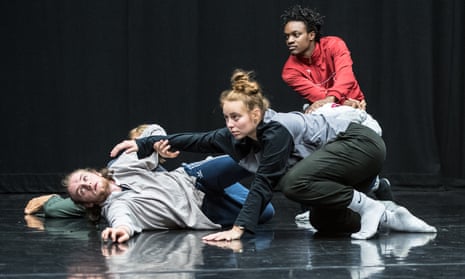“I always say I just want to save the world,” says 22-year-old Ruby Portus, sheepishly. “Some days, yeah, I think I can do that with dance. Other days I think I need to be out on the oceans with Greenpeace.”
Portus is one of four young choreographers sitting around a table with me at Sadler’s Wells in London. Four young people with bright eyes, burning energy and beautiful idealism, who have recently been named young associates at the theatre, which is marking its building’s 20th anniversary this week by asking what the next 20 years of dance might bring. What does millennial dance look like? What about the choreography of Generation Z? How are the dreams, frustrations and fixations of younger generations going to be reflected on stage?
These four should know. All born in the mid-90s, Portus, Anthony Matsena, 24, Wilhelmina Ojanen, 23, and Christopher Thomas, 22, fall on the cusp between generations. “What’s a millennial?” one of them asks, and we try to sum up some of the traits: digitally connected, switched on to gender politics, with fluid ideas about sexuality, and frustrated by the world they’ve inherited with its dwindling hopes for jobs and homes. “I’m such a millennial,” groans Portus.

They come from different backgrounds and take in a wide range of influences – from ballet, contemporary dance, physical theatre, Stanislavski and method acting, krumping and popping, contact improvisation. But they all lean towards political engagement, which gives a hint of what might be to come.
“The landscape is changing,” says Matsena. “How we want to approach dance and what we want to say, it’s very much about the times now. We’re resisting what we don’t like. And we have the courage to speak out about those things. There are strong messages about what we care about.”
For Matsena, this is empowering those who feel dispossessed; for Portus, women’s rights; for Ojanen, humanitarian issues; for Thomas, looking at people affected by trauma. “We each deal with different themes, says Ojanen, “but it’s all relevant to contemporary societal issues.”
Matsena, who was born in Zimbabwe but grew up in Swansea, saw poverty and people who felt they had no agency to change things. The idea of everyday heroism runs through his work. “I want to make people around me feel that they have the power, the courage and the strength to act upon something,” he says. “You’re the hero.”
Do they want to rebel against what’s come before in dance? “Yes, yes, yes, definitely!” come all the voices around the table. So what old ideas will they be sweeping away?

Beautiful abstraction is not for them. Virtuosity for its own sake is out. As is striving to shock or cause offence for kicks. “Not conforming to outdated ideas about certain things, like what is “beautiful” on stage,” says Portus.
After what they see as a trend for ever-more complex movement, accelerating speed, bodies contorted at extreme angles and hugely impressive physicality, they want to move towards something more human, more intimate.
“I think a dancing performer can be impressive in other ways,” says Portus. “For me, building upon ‘real’ dancing is important,” says Ojanen, “to show real people on stage, to show real presence, without all this crazy [technical] stuff. Subtlety, for me, is something that makes me go ‘wow’, the focus on detail not spectacle. I think right now in dance that’s a courageous thing to show.”
Thomas agrees. “In some ways it’s quite a simple thing to want someone to feel something, whereas doing crazy abstract choreography is maybe seen to be a bit more complicated and interesting. But the emotional side of things is not looked at enough.”
“I feel like it’s rebellious to show emotion on stage and make audiences feel something,” says Ojanen. So they’re looking for a more direct means of communication? “Yes!” they say together.
Thomas’s latest work looks at the trauma of a couple unable to have children – a mature subject for a 22-year-old man, I suggest. Is there a new seriousness taking hold? “We are quite serious about stuff, but that way we can then start to change things,” he says. “Definitely there’s a fire inside,” says Portus, “but it’s working out how to use that productively.”
Ojanen wants to use her work to remind us all to treat each other better. “We need more empathy, more connection,” she says. “It sounds cheesy but it’s true. I want, somehow, through my work, to make a case for hope.”
Young Associates – Mixed Bill is at Sadler’s Wells, London, 9-10 October

Comments (…)
Sign in or create your Guardian account to join the discussion